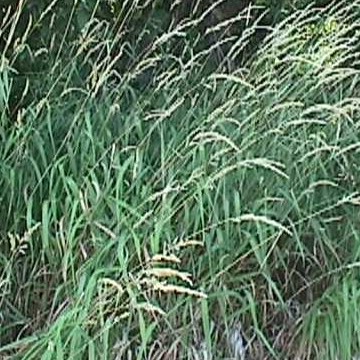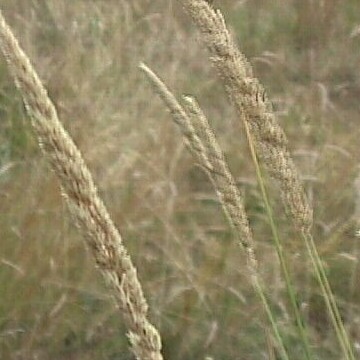

General species Description
- Reed Canary-Grass is a tall, coarse, perinneal grass with creeping rootstocks and stout, erect stems up to 4.5 feet. It is light green to straw colored, with long, wide leaves and swollen stem nodes; stems are erect, up to 1 cm thick, and becomes reddish near the top. Its inflorescence is a narrow, compressed panicle, which distinguishes it from other species. The leaves are wide and flat with prominent nodes. The stems of Reed Canary-Grass are robust, bamboo-like, smooth and occasionally branching at the nodes. Its ligules are membraneous, obtuse, and have a pointed-folded tip. Only one lemma per 3-flowered spikelet will be obvious, the others appear as basal bristles 1-1.5 mm long at the bottom of the central lemma. It is also shade intolerant.
Leaves
- The leaves of Reed Canary-Grass are flat and numerous, up to 5-15 mm wide and 30 cm long. This species also has open sheaths and overlapping margins. Its ligules are 4-10 mm long, usually tattered and turned backward, slightly hairy with no auricles. Leaves are blue-green when fresh, straw colored when dry.
Inflorescence/Flowers
- The inflorescence of Reed Canary-Grass consists of a one-sided, compact, panicle to 25 cm long. Panicles are pale green or tinged with purple in spring, and fade to straw color in late summer. The flowers are borne in dense, compound clusters up to 18 cm long, narrow and erect at first, with the branches spreading slightly at maturity. Blooms June through August.
Fruits
- The glumes of Reed Canary-Grass are 4.5 mm long and minutely hairy. Fertile lemma are up to 4mm long, shiny, and flax-like; sterile lemmas to 2mm long, brownish and hairy.
Habitat
- Red Canary-Grass dominates areas that are irregularly inudated. It will not persist under water for an entire growing season. It commonly grows in swamps, lake margins, and road side ditches. It also grows in disturbed locations, both wet and dry, and is a dominant species in emergent wetland meadows. It also can be associated with Reed Mannagrass (Glyceria grandis), Tall Fescue (Festuca arundinacea), and Orchardgrass (Dactylis glomerata).
Range
- Reed Canary-grass is a Eurasian native. It is one of the most broadley ranging and commonly occuring species in the Pacific Northwest. It is found in all counties of Northwestern Washington.
Similar Species
- Reed mannagrass can be distinguished from Reed Canary-Grass for it has closed sheaths, no auricles, and an opened diffused panicle. Tall Fescue can be distinguished by its open inflorescence and much larger spikelets. Orchardgrass (Dactylis glomerata) can be distinguished from Reed Canary-Grass because it tends to grow in drier habitats, has a less pointed inflorescence and closed sheaths. The color of the leaves are generally the same, but they are more narrow.
Ecological values.
- Reed Canary-Grass is not considered to have a significant wildlife value once it has dried, although many wildlife species find it attractive for cover. In fact, many consider it a pest that out-competes other species and forms monocultures. The form found west of the Cacades (and now throughout most of North America) is thought to be an aggressive cultivar introduced for wetland forage, erosion control, sediment retention, and water quality protection from the 1930's until the late 1980's. Its use is now discouraged because of its highly invasive nature. Canarygrass is also planted in wet agricultural areas for pastures. It produces high biomass, providing organic matter for detrital-based food chains. It also has a high tolerance to salt and nitrates, and it is difficult to eradicate. Additional uses of Reed Canary-Grass is that it provides food, cover and a nesting habitat for waterfowl, marsh birds, and small animals. .
Human Value
- Reed Canary-Grass was a staple in Indian technology. The Okanagan-Colville Indians used it to weave eating mats and mats for drying roots and berries. Some of the women used to weave peaked hats from it suitable for wearing by Indian doctors, and for binding fishing weirs. It is used in basketry and the variegated varieties are used as garden ornamentals..
References
- Cooke, S.S., ed. 1997. A Field Guide to the Common Wetland Plants of Western Washington & Northwest Oregon. Seattle Audubon Society and Washington Native Plant Society. Seattle Audubon Society, Seattle WA.
B.J. Guard. 1995. Wetland Plants of Oregon & Washington. Lone Star Publishing, Richmond WA.
Pojar, J. and A. MacKinnon. 1994. Plants of the Pacific Northwest Coast. Lone Star Publishing, Richmond WA.
Turner, N.J., R. Bouchard, D Kennedy. 1980. Ethnobotany of the Okanagan-Colvile Indians of British Columbia and Washington. British Columbia Provincial Museum, Victoria, British Columbia.
This page was created by: Kirsten Johnson, August 2000
Return to Northwest Oregon Wetland Plants Project